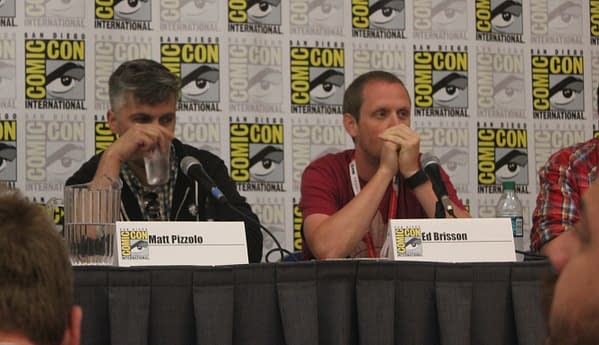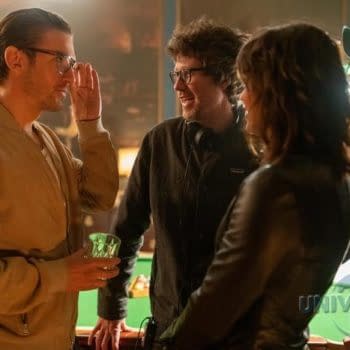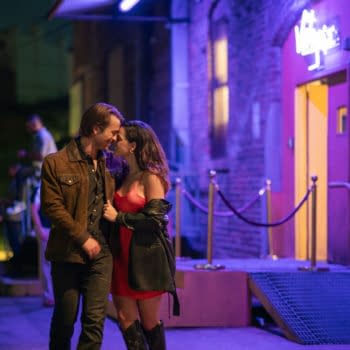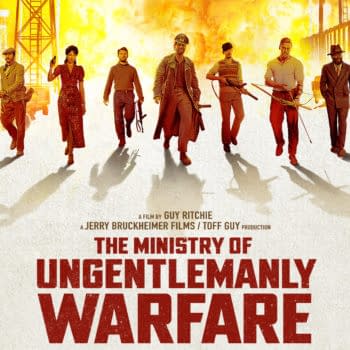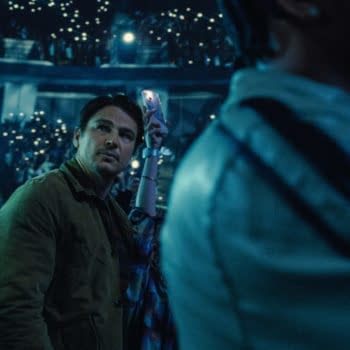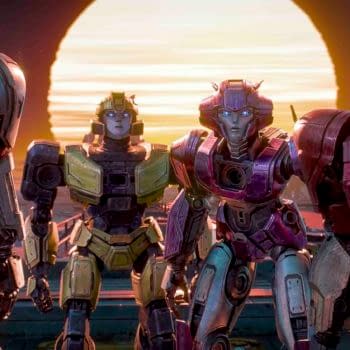Posted in: Movies, san diego comic con | Tagged: Aaron Moorhead, Comics, Ed Brisson, film, horror, Justin Benson, Mark L Miller, matt pizzolo, Matthew Rosenberg
SDCC '15: Horror Creators Talk Inspiration In 'Reinventing Horror For Comics And Film' Panel
Mark L. Miller (Pirouette, Ain't It Cool News editor) moderated a panel titled Reinventing Horror for Comics and Film. He gathered together a well-rounded group of comics and film creators for the evening to talk about horror. His panelists included Aaron Moorhead (writer/director of Spring and Resolution), Justin Benson (writer/director of Spring and Resolution), Matt Pizzolo (publisher of Black Mask Studios, Godkiller), Ed Brisson (Sheltered, The Mantle), and Matthew Rosenberg (We Can Never Go Home).
Miller asked the panel, "What brings them back to horror?" Rosenberg realized that the things he cares about are those things that make him the most uncomfortable. Moorhead stated that horror is the "red-headed stepchild genre" but it is a genre that reflects upon what is to be a human being. Pizzolo said that horror has a strong fandom that inspires him; community support is important to him. Brisson believes that horror is deeply engrained in his psyche because he watched so much VHS horror as a child. Benson said that horror has a long tradition of using homage and tropes. For the films that he and Moorhead have directed, they have sought to reinvent those tropes rather than to rehash them.
Miller then asked the panelists to explain their thoughts about horror. Benson said there was an expectation to use homage in horror however he and Moorhead wanted horror that, was on a conceptual level, horrific. Pizzolo was very interested in using fear as a way to tap into horror, especially as he was most familiar with the 1990s body or slasher films. Brisson and Miller prefer horror that hits them at a personal level.
Next, Miller brought up the tricky balance of humor in horror. Does humor belong in a horror film? Do the lines blur? Moorhead said there are no rules about humor in horror as long as it works. He described humor as currency that can be cashed in. Benson related that he comes across producers who don't understand the importance of humor as an element in horror films that provide, as Rosenberg calls, the "rollercoaster of storytelling that creates a wider range" to horror. Brisson added that he thought that humor has a humanizing effect. Moorhead expressed that it is disrespectful to the fans for the producers to expect that the fans want a familiar plot and characters they have seen before.
As the hour was drawing to a close, the panelists talked about where their ideas come from, which is typically from their own fears. Benson prefers to use allegory in his horror and Moorhead expanded to add how fearful real life events are, such as death right around the corner. Rosenberg stated that he watched a lot of horror as a kid and what scared him then, doesn't do so now. He figured that perhaps he had become desensitized to horror. However, like Moorhead, he is more apt to be terrified of real life, such as being in prison. Miller said he felt that horror was a metaphor for dealing with issues.
Event photos were taken by Michele Brittany.
Michele Brittany is an independent popular culture scholar and semi-professional photographer and editor of James Bond and Popular Culture: Essays on the Influence of the Fictional Superspy (McFarland & Company) as well as the forthcoming book Essays on Space Horror in Films, 1950s – 2000s. Read her reviews and analysis on the spy/espionage and space horror genres via her blogs at Spyfi & Superspies and Space Horror Films. Follow Michele on Twitter: @mcbrittany2014.



